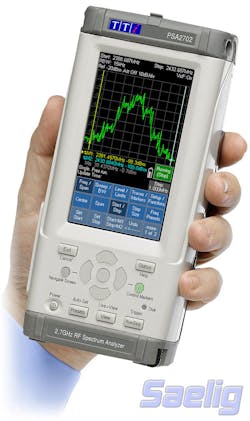The PSA Series II line of microwave spectrum analyzers includes 1.3- and 2.7-GHz versions, with long rechargeable lithium-ion battery life of more than eight hours per charge to assist in-field testing. Both instruments incorporate a 4.3-in. (11-cm) backlit thin-film-transistor (TFT) color touchscreen display. The PSA Series II PSA1302 spans 1 to 1300 MHz, while the PSA Series II PSA2702 operates from 1 to 2700 MHz. Both instruments feature a noise floor of -100 dBm and 80-dB dynamic range. The resolution bandwidth can be set as fine as 15 kHz. The ruggedized casing incorporates a rubber protection buffer, a bench stand, and screen protection. For bench-top use, the instrument can be operated continuously from its AC charger. The compact handheld spectrum analyzers weigh only 20 oz. (560 g) with simple operation from the finger-operated touchscreen display.
Saeling Co., Inc., 71 Perinton Pkwy., Fairport, NY 14450; (888) 7-SAELIG, (888) 772-3544, (585) 385-1750, FAX: (585) 385-1768, e-mail: [email protected], www.saelig.com.
About the Author
Jack Browne
Technical Contributor
Jack Browne, Technical Contributor, has worked in technical publishing for over 30 years. He managed the content and production of three technical journals while at the American Institute of Physics, including Medical Physics and the Journal of Vacuum Science & Technology. He has been a Publisher and Editor for Penton Media, started the firm’s Wireless Symposium & Exhibition trade show in 1993, and currently serves as Technical Contributor for that company's Microwaves & RF magazine. Browne, who holds a BS in Mathematics from City College of New York and BA degrees in English and Philosophy from Fordham University, is a member of the IEEE.
